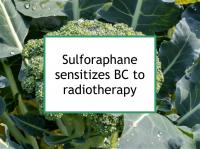The cruciferous vegetable compound indole-3-carbinol (I3C) and its major major digestive product, 3,3'-diindolylmethane (DIM), both have been reported reported to enhance the sensitivity of breast cancer cells to radiation treatment. Now a new study has reported that sulforaphane, another compound derived from cruciferous vegetables, also sensitizes breast cancer cells to radiotherapy.
Food sources of sulforaphane
The following cruciferous vegetables are abundant sources of sulforaphane:
- Broccoli
- Broccoli sprouts (has the highest content)
- Brussels sprouts
The following are good or very good sources of sulforaphane or isothiocyanates structurally and metabolically related to sulforaphane:
Latest research reports sulforaphane acts as radiosensitizer
The study referenced above was designed to investigate sulforaphane's potential to increase the treatment effects of radiotherapy in breast cancer cells. To conduct the study, the authors tested the anticancer and radiosensitizing effects of sulforaphane in MCF-7 (ER+/PR+) and MDA-MB-231 (triple negative: ER-/PR-/HER2-) breast cancer cells. The apoptosis (a type of programmed cell death) level and cell cycle alterations were measured. BCL-2 and BCL-XL (which block apoptosis) gene expression and protein levels were also assessed.
Treatment with sulforaphane alone was shown to reduced the viability of both types of breast cancer cells. Combining sulforaphane with radiotherapy caused much more substantial anticancer effects. In particular, sulforaphane plus radiotherapy increased the number of cells in the G2/M phase of the cell cycle (thereby potentially interfering with mitosis) and the percentage of cells going through apoptosis.
This was a result of sulforaphane-caused reduced expression of BCL-XL; further testing showed that BCL-XL protein levels were decreased in all tested cells. However, the combination treatment cause downregulation of the BCL-2 protein only in the triple negative cells (possibly suggesting a stronger radiosensitizing effect of sulforaphane in triple negative cells). The authors conclude that sulforaphane acts as a radiosensitizer by increasing apoptotic cell death and downregulating anti-apoptotic genes in breast cancer cells.
Please see our article on foods to eat and avoid during radiation treatment and the sulforaphane tag for more information.
